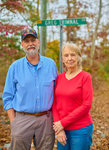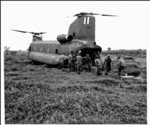

Author’s note: It is with some reluctance that I write and share this story. Veterans will understand this internal conflict about war: to share, versus pain and privacy. With encouragement to overcome my reluctance from my wife, Marie, and Bill Horner III, the publisher and editor of this newspaper, and with Veterans Day approaching — along with the need to honor some veterans who gave all — I am relenting with the acknowledgment that I am but a small part of the following account whose goal is to recognize others.
As Veterans Day approaches, my memories of war are stirred. It was August 1969 when I had a chance to move from crew chief on aircraft #64-13161 to an additional replacement ship — as aircraft were called — as flight engineer on one of our nation’s largest and fastest helicopters still in use today, a Boeing manufactured Chinook CH-47 being used by the Army.
I flew out of a base camp Northwest of Saigon, Phu Loi, supporting many American units as well as Allied Forces from Thailand, Australia and South Vietnam. I had already been flying many months with three of a five-member crew when a coveted opening occurred for a flight engineer position; this was a position I was in line to receive.
Few were granted the opportunity to be assigned their own helicopter that came with the role. Although flight crews tended to stay together as a team, only the flight engineer stayed with his ship wherever it went — to include general maintenance, major overhauls and standbys. The two pilots always rotated, and the left side door-gunner and the crew-chief (additionally, right-side door-gunner) would rotate to another ship whenever their primary ship wasn’t flying. There were never enough helicopter crews to be permanently assigned to a ship except for the flight engineer.
Another flight platoon crew chief, Greg Trimnal, from Jamestown, N.C., had also been promised his own ship as a flight engineer in the future but was home on leave after extending his year-long tour for an additional six months. Flight crews were in short supply and the best were encouraged to stay on, their extensive knowledge invaluable. Greg happened to return at the same time a newly refurbished ship, #64-13141, was ferried in from Saigon. I met up with Greg as we approached what each of us thought was our ship!
It was the first and only time I met Greg; we happened never to have flown together.
After the initial shock of two people each thinking this ship was his, a lengthy discussion ensued. I expressed a desire for the position and energetically lobbied for the unique opportunity. Greg was a bit more laid back after 30 days home leave and fully rested as he took in the dilemma. I proposed that Greg might take the next available ship, which led to more discussion. He seemed amenable so I suggested we just switch places on the flight roster. Greg could fly on sister ship #64-13161, taking my place as their crew chief and I would take 141 as flight engineer. There was, however, one more hurdle: flight sergeant approval.
The flight sergeant listened to the proposal and checked for genuine agreement. He said that if Greg and I were OK he would support the move. Greg and I walked out to the flight-line where I introduced him to the flight engineer of 161 — Jim Mott, my best friend — and door-gunner Scott Verner (a valued flight partner and friend). I left as the pilots Robert (Bobby) V. Gray (he was my age with a friendly, carefree style) and Marvin J. Butterfield (he had less than a month in-country), arrived to do their pre-flight inspection for the day’s missions. I returned to 141, my new (actually 5-year-old) ship, to prepare and outfit it for close combat support.
My friend Jim Mott was not surprised at my reassignment to the new ship as we had celebrated the previous night in the flight platoon hootch (living quarters) we shared; I took his picture. Jim Mott and I were both unaware at the time that two crew chiefs would be showing up for one flight engineer position in a conflicting situation the next morning, but Mott had been expecting a replacement crew chief, nonetheless.
Aug. 30, 1969, is indelible in my mind, but the exact timing during the remainder of that day is now a bit blurry.
161 took off with its five-man crew for the day’s sorties as I continued to work on 141. Sometime later, word came out along the flight-line that one of the company’s ships went down. I went to the flight operations shack to get more information. The report came in by radio that the downed ship was 161 but there was little additional information just then. The mission board showed the ship had been supporting the Australians out of Nui Dat base camp. More info started to come in that the ship had crashed in the jungle short of their intended LZ (landing zone), FSB Diggers Rest. The jungle, the ship’s jet-fuel, and the exploding ordinance the ship was carrying prevented on-the-ground field forces from quickly getting to the downed ship.
A little later, it was reported that there were no survivors of the five-man crew.
I was later able to fly over the crash site; the outline of a Chinook was burned into the jungle. The cockpit was separated from the rest of the ship and the pilots, Bobby Gray and Marvin Butterfield, had been intact in their seats but were dead. Jim Mott, Scott Verner and Greg Trimnal were consumed by the fire that completely burned the remaining 52-foot fuselage except for the massive aft rotor head.
There was hardly time to grieve as “war waits for no-one” practicality came into play. Flight operations continued except for a short ceremony at the company headquarters. I represented Jim Mott; others from the flight platoon represented the other crew and pilots. War-guilt and moral injury to the soul came years later, a common War-Veteran issue.
Through the ensuing years, I did not discuss my two-tour Viet Nam service. And, because of the terrible homecoming reception in the U.S. upon my return and for over 35-years, I did not publicly or privately identify as having served in the military, especially Viet Nam.
Only recently did I start to wear a Viet Nam baseball type hat identifying me as a Veteran.
My wife Marie and I moved to Pittsboro in 1994 as “empty-nesters.” Our three sons — Rick, Jeff and Glen — were grown and gone and onto their own lives.
After a few years we looked for a larger piece of land as the area we were in was beginning to be built out. In 1997, we found a 113-acre site that appealed to us and purchased it. We carved out a few homesites from the heavily wooded property and moved onto it in late 1999. Part of that process was to build a private road into the property. Marie and I discussed road names. We quickly realized the opportunity to recognize and honor the sacrifices made that enabled me to literally continue my life. We decided we would name our road: Greg Trimnal Circle and look for opportunities in the future to name other areas of our land after the rest of the crew of 64-13161.
I wrote and spoke on the phone with Greg’s mom, Alice, at that time; she thought it wonderful that her son would be so honored (I was humbled by her graciousness and support). I also kept up with Jim Mott’s mom, Gwen, yearly until she died. And had the opportunity to meet Bobby Gray’s sister, Margie, when she stopped in to visit on her way from Ohio to Florida curious to see the road sign.
Recently, we decided to downsize our land a bit and put in four 10+ acre lots and a new private road as access to these lots and our certified tree farm. This presented an opportunity to add more crew names to the site. The small “exempt” subdivision is to be named “Verner’s View” and the road “Jim Mott Bend” due to the large arc it makes. The Chatham County EOC and the Planning Department assisted in the process during development reviews. Eric Andrews has supplied direction and real estate support and Paul Messick has provided legal advice. A formal dedication will be announced in the future as the project hopes to come to completion later this year or early next.
Two more names of the five-man crew remain to be memorialized somewhere on the property in the future. Marie and I are honored for all the support and this opportunity to move closer to our goal of recognition for the ultimate sacrifice of the crew of 161.
Oh, how I miss them!